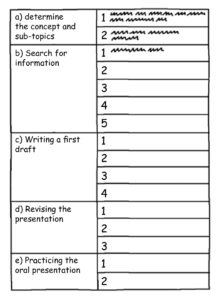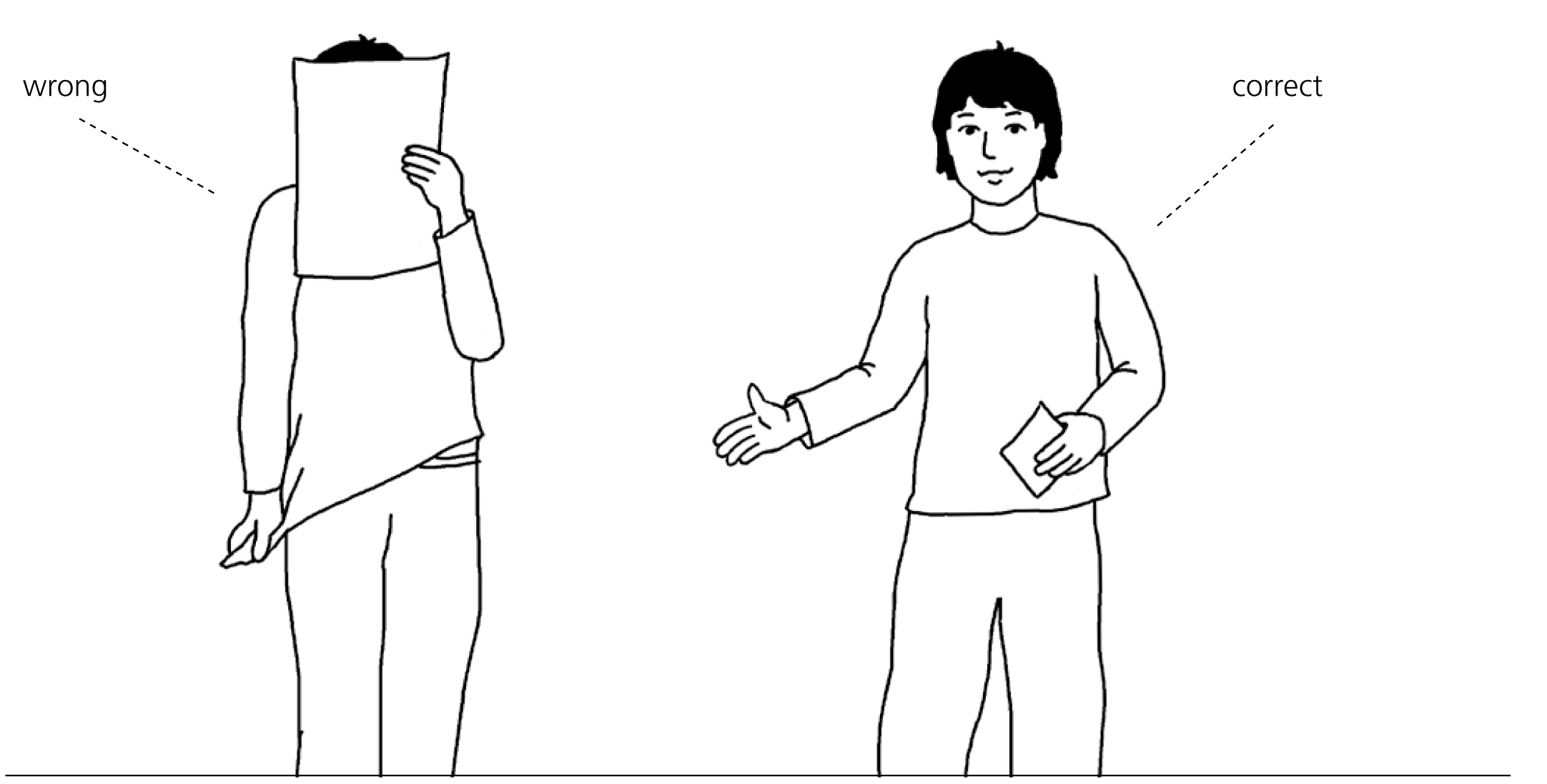14.1
Choice of topic
If you may select the topic yourself, then consider carefully …
… which theme, point of view or aspect interests you?
… if you already have previous knowledge upon which you can build?
… if you know people, books or other sources of information that could help you with your topic?
Think about all these points and take notes. Only decide on a topic when you are absolutely certain!
14.2
Planning the work: creating an action plan
A big task must be well planned and divided into partial steps. The important thing is to begin early and to allow yourself sufficient time.

Make an action plan for two to three weeks with the following work steps:
a) Concept; determine the subthemes (1–2 days)
b) Search for information (3–5 days)
c) Writing a first draft (2–4 days)
d) Revising the draft (2–3 days)
e) Practicing the oral presentation (2 days)
Write the outline of this action plan on a large sheet of paper.
Record in this field every day exactly what you have done.
14.3
Concept: determining partial themes/sub-topics and structural development
Consider and write down which partial themes you want to discuss and how you want to structure your presentation. Here are a few hints concerning the structure:
- In the beginning of the presentation you should give an overview and a short introduction to your topic.
- In the main part or middle section of your presentation you should address various parts or sub-topics. Consider carefully which sub-themes you choose and in which sequence you address them.
- In concluding, give a short summary or express a few personal thoughts and considerations about the topic.
Write the concept on a large sheet of paper. Study the individual parts and make notes about them.
14.4
Seeking information: compiling everything worth knowing about the topic
Take a few days to compile all information about your theme and the various sub-themes. Include pictures, excerpts from an interview or things that you can show as interesting elements of your presentation.
Make notes about your information, using various colors.
14.5
Writing a draft

Write a first version of your presentation. Think about the time you have available! Note also when you want to show something (pictures, objects, something on the computer) and where you may want to involve the audience.
At the end, read your text aloud and time yourself. Are you more or less within the time frame that you have available?
14.6
Revising the draft
Read your presentation to someone. S/he should tell you what was good, what was unintelligible and what was somewhat boring.
Go through your presentation section by section. Write a good, readable final version.
Pay particular attention to the following points:
- Make sure that you have an exciting introduction/beginning! Example: an interesting question, a personal anecdote, a surprising picture.
- Pay attention to a clear structure. Inform the audience about the structure of your presentation. Announce the beginning of a new chapter or partial theme.
- Strive for a simple, clear language. If there are technical terms in your presentation or difficult terms, explain them briefly!
- Include pictures, transparencies, the computer, audio documents, use You Tube videos or other media in order to render your presentation more lively and graphically.
- Make sure that the conclusion of the presentation is exciting as well.
- Example: you end your presentation with a question addressed to the audience or you summarize the most important aspects.
- Depending on the topic, you must also reference the sources of your information.
Consider also…
- … if you want to prepare a few questions for a final discussion,
- … if you want to prepare a worksheet or quiz with questions about the presentation,
- … if you want to write a summary with the most important information for the benefit of your classmates.
14.7
Practicing the oral presentation
Now give your speech a few times, just as you would do in class (including all pictures, media, etc.). The more freely you speak, the better.
It is particularly useful if someone is listening to your practicing of the speech. S/he can tell you, for instance, when you speak too fast or too quietly or whatever else is distracting.
Proceed as follows when practicing:
- In the beginning read the text off the page, but try already to sometimes lift your eyes from the page and make eye contact with the audience.
- Mark the particularly important passages in the text and try to look only sometimes at the page. Otherwise, look at the audience and try to calmly move a little.
- Now try to give the entire presentation freely without the text. To avoid forgetting something, you may create small cards or pieces of paper with keywords for every sub-topic.
What should not happen:
- Speaking too quietly or too fast.
- Speaking in a monotonous voice, i.e., without changing the volume or the pitch.
- Rushing through the text, without ever making a pause.
- Standing stiff and cramped in front of the class without moving.
- Remaining glued to the pages, without ever looking at the audience.
It is best if you ask someone to observe you and to tell you what was good and what was not yet so good.

And here is a last tip:
Before you give the presentation in class: check,
… if you have everything you need,
… if the technology functions (in case you make use of the computer and a projector.






